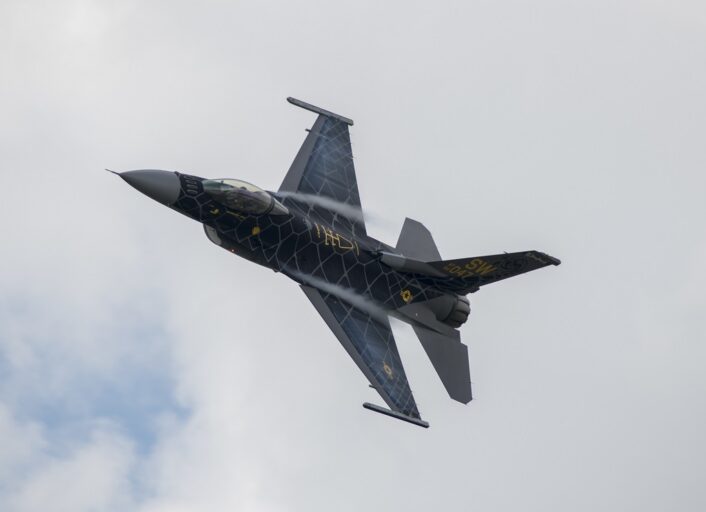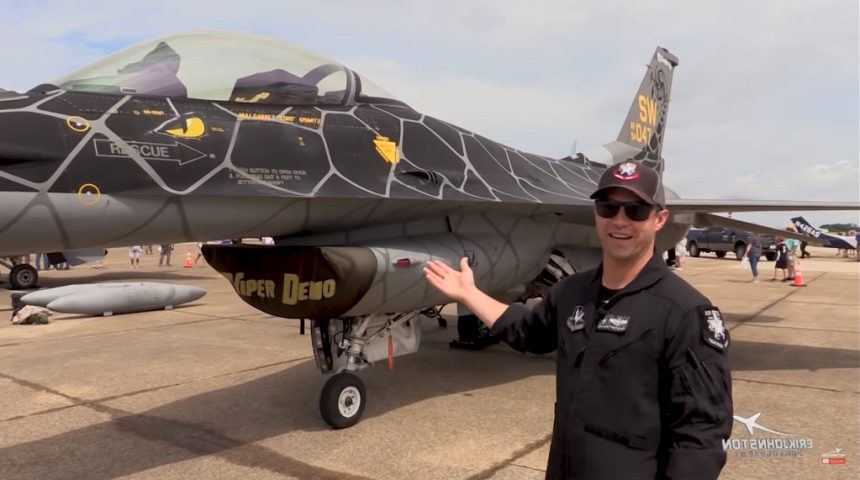Maj. Garret “Toro” Schmitz takes us through a tour of his specially painted F-16: “Venom”.
The F-16 Fighting Falcon is the world’s most popular fighter aircraft, with more than 4,600 aircraft delivered to about 30 different countries. Almost half of those, 2,231 to be precise, were delivered to the U.S. Air Force, which is the largest operator of the type with about 1,000 still in service. To showcase the capabilities of this highly successful fighter jet, the Air Force stood up the Viper Demo Team, from the nickname given to the F-16 by pilots and crews.
In the latest episode of his walkaround series, our friend Erik Johnston brought us a tour of the F-16C Block 50 with the Viper Demo Team’s pilot and commander, Major Garret “Toro” Schmitz. Featured in the video is the F-16 #94-0047 which was painted in a special livery, nicknamed “Venom”, and unveiled shortly before the beginning of the 2020 airshow season. Inspired by the F-16’s nickname, snake scales are painted across the airframe, painted in the team’s signature black and yellow colors.
Maj. Schmitz quickly pointed out, at the beginning of the video, an interesting detail about the design of the “Venom” livery. The Viper Demo Team’s patch features a snake coming out of it, so the livery has been designed as if the aircraft was an extension of that snake, originating from the patch painted on the tail and going all the way to the front of the F-16, which represents the head of the snake as it can be seen from the eyes painted below the cockpit.
The clean F-16 can showcase its power and maneuverability in a unique way, compared to an aircraft with its usual loadout of fuel tanks, pods and weapons. For example, as explained by “Toro”, a normal rotation speed of a Viper at mil power (max power without afterburner) would be 146 kts with a takeoff speed of 156 kts. The F-16 in a clean configuration for the demo executes a high-performance takeoff, rotating at just about 100 kts and lifting off at about 120-130 kts in 900 ft of runway.
This is also thanks to the F-16’s engine, which provides 30,000 lb of thrust to the 28,000 lb jet in clean configuration. In this “sports car” version, the pilot can show the crowd what the F-16 can do low to the ground and at the edge of its flight envelope. This completely clean and sleek configuration also allows the Viper to supercruise (as you may already know, supercruise is the ability of an aircraft to fly supersonic without using the afterburner.

The tour continues with a description of the Viper’s mission capabilities, which evolved from a day only lightweight fighter to an all-weather multirole fighter aircraft. A unique mission of the F-16 Block 50 is the Suppression and/or Destruction of Enemy Air Defenses (SEAD/DEAD), with Shaw Air Force Base, the home of the Viper Demo Team, being the only active-duty CONUS-based F-16 base with this task. The F-16 is considered an ideal aircraft for this mission as, thanks to its high maneuverability, it can create a large miss distance should it not be able to hit threat radars before being engaged.
For the “Wild Weasel” role, the F-16 is equipped with dedicated systems, such as the AN/ASQ-213 HARM Targeting System (HTS) pod, the AGM-88 HARM (High-speed Anti Radiation Missile) missile and Electronic Counter Measures pods, usually the AN/ALQ-131 and AN/ALQ-184 self-protection jammers. The HTS pod allows to identify and locate active threat radars and pass the info to the HARM for the engagement. The pilot has also the option of using the HARM as a sensor, but the HTS pod allows more flexibility.
Another particularity of the F-16 is its hydrazine-powered Emergency Power Unit (EPU), which provides enough power to the flight controls to fly the aircraft should it lose the engine. Being completely Fly By Wire and without mechanical connection between flight surfaces and the controls in the cockpit, the F-16 uses the EPU as the last resort among its multiple redundancies to allow the pilot, in the event of a complete power failure, to fly the aircraft to a safe place to land or a location where an ejection can be performed safely.
An interesting mention goes to the wingtips’ missile rail launchers, which are never removed even if the F-16 is in a clean configuration. The reason for this is simple, as explained by Maj. Schmitz: their presence allows pilots to take the Viper to its extreme limits as they provide stability to the wing. Without the MRLs, the aircraft would be airspeed-limited and G-limited because the wing would resonate in certain flight conditions, causing what is known as wing flutter.
The presence of a missile of a pod on that rail provides even more stability, but that is not the sign of a wing which is not sturdy enough for its job. As Toro mentioned, the wingtip can easily hold a 500 lb missile (probably referring to the AIM-120 AMRAAM, with a weight of about 350 lb), which at 9G translates in 45,000 lb, and the wing has absolutely no issues with it.









